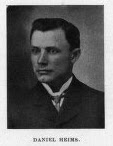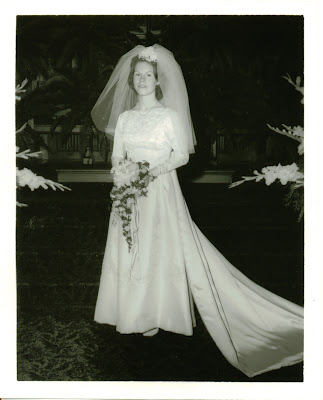Discover more about your own family living in the Emerging America historical period of 1880 - 1920.One of my long-term goals in genealogy is to research in depth the lives of each of my ancestors through my great-great-grandparents' generation. With that in mind, I've created a
checklist of all the records I hope to find for each of them, the information from which I try to weave into comprehensive and comprehensible biographies for my
AnceStories website.
I've been able to obtain marriage records for every ancestral marriage through my great-great-grandparents' generation, with the exception of two couples,
James L. YORK and
Mary "Mae" E. McARTHUR (on my dad's side), and Charles Frisbe STRONG and Mary Lucy WRIGHT (on my mother's side). I do have a year and place of marriage for Charles and Mary (1873; Fairfield, Town of Candor, Tioga County, New York), which was discovered by a cousin of mine; I just haven't obtained a document verifying this. But for James and Mae, I have nothing: no date or place of marriage.
 James L. YORK, c. 1880s
James L. YORK, c. 1880s Mary "Mae" E. (McARTHUR) YORK RANDELL, c. 1920s - 1930s
Mary "Mae" E. (McARTHUR) YORK RANDELL, c. 1920s - 1930sHere's what I do know: James L. YORK was born 7 October 1867 in Goodrich, Atlas Township, Genesee County, Michigan to
John H. YORK and Anna CROTHERS, the youngest surviving child of their seven children. Mary E. McARTHUR was born 28 January 1875 in Washington Township, Gratiot County, Michigan. Her parents were Daniel J. MacARTHUR (a Civil War veteran) and Martha JOHNSON. She was the fifth child, also of a family of seven children.
How this couple managed to meet each other is still a mystery to me. Gratiot County is two counties west of Genesee and Lapeer Counties, where most of the Crothers and York families had settled. Anna had two siblings, Nancy Amanda (CROTHERS) PHELPS and Moses CROTHERS (not verified he is a sibling) who lived in Clinton County, which is bordered by Gratiot County on the south; however, the Clinton County townships that these two lived in were not near Washington Township. I do know that James' first cousin, Jennie Mae EBLER (daughter of Wilhelm D. EBLER and Elizabeth June CROTHERS) married Mae's brother, Daniel Thomas McARTHUR, but they appear to have married after James and Mae did, sometime around 1907 or so.
 Ernest, Howard, & Hazel YORK, c. 1900
Ernest, Howard, & Hazel YORK, c. 1900James and Mae had three children: Ernest Lee (1894 - 1976); Hazel (1895 - 1967); and
Howard Merkel YORK (1898 - 1945). Howard was my great-grandfather. Since Ernest was born on 12 April 1894, I can make an educated assumption that James and Mae were married by 1893. Ernest and Howard both gave their birthplace as Goodrich on their marriage records; and indeed, the family is enumerated there in the 1900 U.S. Federal Census. However, none of the children's births are found in Genesee County birth records as confirmation. Goodrich is a village in
Atlas Township, which sits in the southeast corner of Genesee County, which is bordered by Hadley Township in Lapeer County on the east, and Brandon Township in Oakland County on the south. The children's births aren't recorded in those counties, either. And Howard's obituary states he was born in Ortonville, Brandon Township, Oakland County; although I'm sure the information was given to the newspaper by either his second wife or a family friend, neither of whom probably knew for certain where he'd been born. James and Mae's marriage was not recorded in Genesee, Lapeer or Oakland County marriage records, either. The lack of vital records available for this family has been frustrating and puzzling, and hasn't lent itself to uncovering when and where the couple was married!
About a year ago, I discovered that the Family History Library had a microfilm of Genesee County Marriage Records that I had never viewed (FHL microfim 14,815) which included delayed recordings from 1892 - 1929. I sent off for it at once, but for some reason, the film was not allowed to be sent to a Family History Center. I then paid a $4.00 fee to have a FHL volunteer search the index on site for the surnames York or M(a)cArthur to see if the record was contained in that film. The answer came back that the marriage was not listed.
So, do I know if James and Mae were ever actually married? Yes, I do. Years ago, I sent off a request to see if I could find a divorce record for this couple from the Genesee County clerk in Flint. I had obtained a divorce record from this same source for their son Howard and my great-grandmother Mary Jane BARBER, and had found well-detailed information on the divorce which included a marriage date and place. I hoped to find similar information for James and Mae. But instead of receiving a copy of the original divorce certificate or a transcript of the court proceedings (both of which I've obtained from other ancestral divorce records) I received the following document:
I've had this document for several years, and wasn't too sure what it was, other than understanding that it gave a date for the divorce and thus was secondary evidence of a marriage. I asked law professor and
fellow genea-blogger Craig Manson if he would mind taking a look at this and explaining it to me. Here are his comments:
This appears to have been an uncontested divorce based on the the terms in the document. First, the document itself appears to be the court clerk's file index or case index for this case. Court clerks keep track of each document presented to the court. The notation "4299" on the top left is likely the case number. The notation "Fees paid in full" along the left side indicates that all the court fees were paid. The name to the right of James York is that of his attorney, Daniel Heims. Heims was a prominent Flint attorney in the late 1800's/early 1900's, who among other things, helped organize the Genesee County Bar Association. (An aside: Heims, who handled divorces, seems never to have married!)

(Daniel Heims)Here's the sequence of events in 1904:
March 21---Heims files the divorce action on behalf of James York. That same day, a subpoena is issued to demand the presence of Mary York at a hearing set in April.
April 7--The subpoena is returned to the clerk of the court with proof that it was served on Mary York (or that after a diligent search she could not be found within the jurisdiction of the court).
April 12--This was probably the date set for hearing. The "Affidavit of Nonappearance" is either Heims' or James York's declaration that despite having been lawfully served, Mary York failed to appear at the date and time set for hearing. The "Affidavit of Regularity" follows the nonappearance affidavit in that it recites that the defendant was served with the subpoena; states the manner of service; and declares that the plaintiff (James) believes the defendant (Mary) to be in default. It requests the court to proceed with the matter in the absence of the defendant.
May 18--The court issues an "Order Pro Confesso." This is an order that states since the defendant has failed to appear, the facts alleged by the plaintiff will be taken by the court "as if the defendant had confessed" them. The court also issues an Order of Reference; that is, an order appointing a referee to determine the parties' rights in property (and sometimes other duties).
June 2--CCC Report filed. This is no doubt the report of the referee, although I do not know what "CCC" stood for in 1904 Michigan practice.
June 3--The divorce decree is issued. "Ch. De. Bk." may stand for "Chancery Decree Book." In 1904 in most states, divorces were heard in the chancery courts, not the law courts. (The location and people in the chancery courts were often the same as those of the law courts--the distinction goes back many centuries to England and is too long a story to explain here!)
July 9--The decree is final.
Here then is evidence that James and Mae were married. I still will need to do some digging to obtain the actual full court records of this divorce, which should then provide me with the date and place of marriage. Mae remarried very soon after this divorce--on 27 August 1904--to the love of her life, Evan J. "Dick" RANDELL, whose family's farm was just down the road and across the Genesee-Lapeer county line from the York family farm. Because of how quickly Mae remarried, I have often wondered if she and Dick fell in love
before the divorce. When I mentioned that to Craig, he responded with:
What you tell me about Mary's quick remarriage is consistent with a thought that I had--they [husband James and his lawyer] had worked this all out ahead of time and intended to get it done quickly. That's why Mary did not show up [for the hearing].
That might explain James's hiring a prominent attorney to handle the divorce. He may also have been wishing to protect himself from accusations from Mae's attorney about his own behavior. Decades later, when one of Mae's granddaughters was divorced, she made a comment to the granddaughter, saying her granddaughter's ex-husband's actions reminded her (Mae) of her "first husband." This comment was unusual, because Mae rarely spoke of her first marriage. In fact, one grandniece that I spoke with who knew Mae well had never heard of Mae being wed before her marriage to Dick Randell! Only after digging through family papers and finding some labeled photographs of Mae with her sons Howard and Ernest York, was the grandniece convinced that there indeed had been an earlier marriage. According to these family members, James (who later married his housekeeper) retained custody of Ernest and Howard, while Hazel remained with her mother, who had two more sons with Dick Randell. This divorce changed the course of this family and the lives of their children adversely. Hazel seems to have been the most well-adjusted and lived happily with her husband and daughter in the thumb area of Michigan. Ernest and Howard had several marriages each; Howard was in and out of prison a couple of times. I can't help but wonder if the boys' childhoods spent without their mother were the foundation of their difficult lives.
--------------------------------------------------
I've since thought of another place where I could look for a marriage record. Brides were often married in their father's homes in those days, and Mae's parents were living in Washington Township, Gratiot County, Michigan. So if the complete divorce record cannot be found or doesn't yield a marriage date and place, that is another option. Genealogy is full of mysteries. Figuring them out can be, by turns, frustrating, exciting, disappointing, and thrilling!
This post was originally started with the intention of submitting it to the 33rd Carnival of Genealogy, whose topic was "Weddings!" Due to illness, I ran out of time to fully research and write it before the deadline.
Browse news and town records, photos, and military records.










